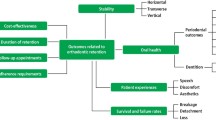Abstract
Data sources
PubMed (1966–April 2004) provided the primary data source along with the bibliographies from identified articles and reviews.
Study selection
As there were no randomised controlled trials, English language prospective and retrospective cohort studies were selected if they had a mean follow-up of ≥5 years, included patients who were clinically examined at follow-up, reported details on suprastructures and described at least one-third of reconstructions as fixed partial dentures (FPDs).
Data extraction and synthesis
Two independent reviewers screened articles for inclusion. Disagreements were resolved by discussion and agreement determined by kappa. Three reviewers extracted data on the survival and success of the reconstructions and on biological and technical complications. Studies deemed sufficiently similar by design were pooled using negative binomial regression with robust standard errors. Ten-year survival risks were calculated using exp(−10 × failure rate) and 10-year failure risks using 1–S(10).
Results
17 retrospective and two prospective cohort studies including 1764 patients with 3548 FPDs analyzed in total. Meta-analysis was undertaken and after exclusion of one outlier a 10-year FPD survival of 92% was estimated. Only four studies provided information on FPD success — pooled complication rate was 34.1/1000 FPD years (95% CI 16–74). Exclusion of one outlier resulted in an estimated 10-year success of 81.1%. Considering biological complications, the estimated 10-years risk for caries at abutments was 9.5% (95% CI 4.6–89.9) while that for FPD loss due to caries and periodontal disease were 2.6% (95% CI 1.6–4.2) and 0.5% (95% CI 0.1–2.2), respectively. Estimated 10-year risks for technical complications were: 6.4% (95% CI 3.9–10.4) for loss of retention; 2.1% (95% CI 1.4–3.2) for loss of FPD due to abutment fracture and 3.2% (95% CI 1.5–6.5) for material fractures.
Conclusions
Estimated success and survival rates for conventional FPDs largely confirm those of previous reviews. Technical complications such as loss of retention, which have not been reviewed before, resulted in a greater risk of FPD loss than did biological complications.
Similar content being viewed by others
Commentary
This systematic review is part of a series of systematic reviews,1, 2, 3, 4 by the same group, addressing the survival and complication rates of fixed partial dentures of different designs.
The objective was clear, to determine the long-term success and survival of conventional fixed partial dentures and to evaluate the risks for failures due to specific biological and technical complications. A range of treatment modalities exist for restoring edentulous spaces and there is a need to undertake a thorough cost/benefit analysis in clinical decision making. The same group has reported on implant-supported FPDs4 and so comparative data on conventional FPDs are of value.
The search while thorough was limited to papers published in the English language. From an initial 3658 papers, only 19 met the clearly defined inclusion criteria, with a total of 3548 FPDs forming the basis of the analysis. Survival was defined by the authors as an FPD that was in situ at the examination visit irrespective of its condition. Success was defined as an FPD that remained unchanged and did not require intervention over the observation period.
The authors reported a 10-year probability of survival for fixed partial dentures of 89.1% (95% CI 81–93.8), while the probability of success was 71.1% (95% CI 47.7–85.2). This is similar to the 10-year survival risk of 90% for FPDs reported in a previous meta-analysis.5 The 10-year risk for biological complications such as caries, periodontitis and loss of vitality were 2.6, 0.5 and 10%, respectively. The 10-year risk for technical complications such as loss of retention, abutment fracture and material fractures were 6.4, 2.1 and 3.2%, respectively. The authors conclude that this review by and large confirmed previously published survival and success rates and those technical complications resulted in a greater risk of FPD loss, than did biological complications.
The majority of the studies analysed were published in the 1980 s and 1990 s. Consequently caution must be exercised in the interpretation of technical complications such as veneer fractures, since most of the studies available for analysis would have reported on gold–acrylic FPDs. Of the seven studies that reported on FPD design (accounting for 2094 FPDs), 11.6% were metal-ceramic while the others were gold–acrylic design.
Furthermore, the authors point out that for some aspects of the analysis the number of studies with valid information was reduced to a few studies only. The results of the biological and technical complications were drastically affected by the incompleteness of reported data in the majority of the studies. The pooled 10-year risk for loss of abutment vitality was 10%; this is in agreement with previous studies.6 It is recommended, that patients treated with FPDs should be closely monitored for the loss of vitality of abutments.
There are long-term biological, technical and financial implications when considering conventional FPDs to replace missing teeth. There is a need for clinicians and patients alike to fully understand the long-term implications of providing such prostheses and to undertake a thorough cost/benefit analysis, when treatment planning for restoration of edentulous spaces.
Practice point
-
While conventional FDPs show good survival rates it is important to understand the levels of biological and technical complications and the implications for treatment planning.
References
Pjetursson BE, Tan K, Lang NP, Bragger U, Egger M, Zwahlen M . A systematic review of the survival and complication rates of fixed partial dentures (FPDs) after an observation period of at least 5 years — IV. Cantilever or extension FPDs. Clin Oral Implants Res 2004; 15:625–642.
Lang NP, Pjetursson BE, Tan K, Bragger U, Egger M, Zwahlen M . A systematic review of the survival and complication rates of fixed partial dentures (FPDs) after an observation period of at least 5 years. II. Combined tooth-implant-supported FPDs. Clin Oral Implants Res 2004; 15:643–653.
Tan K, Pjetursson BE, Lang NP, Chan ES . A systematic review of the survival and complication rates of fixed partial dentures (FPDs) after an observation period of at least 5 years — III. Conventional FPDs. Clin Oral Implants Res 2004; 15:654–666.
Pjetursson BE, Tan K, Lang NP, Bragger U, Egger M, Zwahlen M . A systematic review of the survival and complication rates of fixed partial dentures (FPDs) after an observation period of at least 5 years — I. Implant-supported FPDs. Clin Oral Implants Res 2004; 15:667–676.
Creugers NH, Kayser AF, Van’t Hof MA . A meta-analysis of durability data on conventional fixed bridges. Commun Den Oral Epidemiol 1994; 22:448–452.
Bergenholtz G, Nyman S . Endodontic complications following periodontal and prosthetic treatment of patients with advanced periodontal disease. J Periodontol 1984; 55:63–68.
Author information
Authors and Affiliations
Additional information
Address for correspondence: Ken Tan, Department of Restorative Dentistry National Dental Center Singapore, 5 Second Hospital Avenue, Singapore 168938, Singapore. E-mail: tken@pacific.net.sg
Tan K, Pjetursson BE, Lang NP, Chan ES. A systematic review of the survival and complication rates of fixed partial dentures (FPDs) after an observation period of at least 5 years — III. Conventional FPDs. Clin Oral Implants Res 2004 Dec; 15(6):654–666
Rights and permissions
About this article
Cite this article
Sharma, P. 90% of fixed partial dentures survive 5 years. Evid Based Dent 6, 74–75 (2005). https://doi.org/10.1038/sj.ebd.6400350
Published:
Issue Date:
DOI: https://doi.org/10.1038/sj.ebd.6400350
This article is cited by
-
Comparison of Fracture Toughness of All-Ceramic and Metal–Ceramic Cement Retained Implant Crowns: An In Vitro Study
The Journal of Indian Prosthodontic Society (2014)



